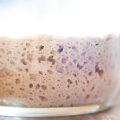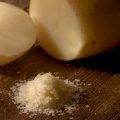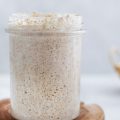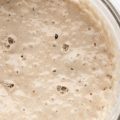Your sourdough starter will be experiencing lots of things. From extreme hunger to stability, it’ll quite literally have you wanting to pull your hair out. Fortunately, there are subtle ways to tell whether your starter is doing well or not. If your sourdough starter smells like vinegar, or is beginning to resemble the familiar acidic scent, and you’re not sure whether that is considered a good thing or a bad thing, then here’s what you should do!

Table of Contents
- What is a Sourdough Starter?
- What Should A Sourdough Starter Smell Like?
- My Sourdough Starter Smells Like Vinegar
- Is a Vinegary Sourdough Starter Safe?
- My Sourdough Starter is Too Sour
- How To Fix A Starter That Smells Like Vinegar?
- How Do I Know If My Starter Has Gone Bad?
- Prevention Techniques – Keep Sourdough Smells Pleasant
- Sourdough Starter Smelling Vinegar
- Sourdough Starter Smells Like Vinegar FAQs
What is a Sourdough Starter?
A sourdough starter is a magical mixture that brings life to your bread, crafted from the simplest of ingredients: flour and water. This dynamic duo creates a nurturing environment for wild yeast and beneficial bacteria to thrive, transforming humble ingredients into a bubbling, tangy, and utterly irresistible starter.
The type of flour you choose can influence the flavor profile of your starter. As you mix the flour and water together, the wild yeast, naturally present in the air and the flour itself, starts to mingle with the friendly bacteria, kickstarting the fermentation process that gives sourdough its distinctive tang and incredible texture.
With each passing day, as you feed your starter with fresh flour and water, you’ll witness it evolve and mature. The bubbles that form on the surface are a telltale sign that your starter is alive and thriving, eagerly awaiting its chance to transform a simple dough into a masterpiece. With a little flour, water, and a dash of dedication, you’ll soon have a bubbly, tangy, and utterly irresistible starter.
As your sourdough starter comes to life, it’s natural to take a whiff and wonder what’s brewing beneath the surface. The symbiotic relationship between wild yeast and friendly bacteria creates a symphony of scents that can tell you a lot about your starter’s health. Let’s dive into the world of sourdough starter aromas and decipher what they mean.
When Things Go Awry: Off-Putting Odors
While a range of scents is normal for sourdough starters, there are some smells that should raise a red flag. If your starter gives off a strong odor reminiscent of nail polish remover (acetone), it could be a sign that it’s starving and needs to be fed more frequently. An overpowering vinegar smell can also indicate an imbalance in the yeast-bacteria relationship.
What Should A Sourdough Starter Smell Like?
Generally, your sourdough starter should emit a wonderful yeasty smell.
A healthy sourdough starter should have a pleasant, yeasty smell reminiscent of beer or ripe fruit. This aroma is a sign that the wild yeast is happily munching away on the flour, producing carbon dioxide and alcohol. If your starter emits this delightful scent, you can be confident that it’s on the right track.
Alongside the yeasty aroma, you might catch a whiff of tangy, slightly acidic notes. This is the handiwork of the lactic acid bacteria, which work in harmony with the yeast to create the signature tang of sourdough. A subtle sourness is a good indication that your starter is alive and well.
However, if it releases an unpleasant smell, then this might mean that your starter is hungry.
The vinegary smell is quite normal, as it is a by-product of acetic acid. The good bacteria in the sourdough starter tend to gobble up the nutrients in the flour, meaning that it’s time to feed your starter once again.
If you’ve noticed a recurring sour smell, you can increase the amount of food you feed your starter.
What Should A Sourdough Starter Look Like?
A healthy and established sourdough starter should have a distinct appearance and texture. After being fed, the starter should look lively and active, with numerous bubbles of varying sizes distributed throughout. These bubbles are a clear indication that the wild yeast and bacteria present in the starter are actively fermenting the flour and water mixture.
The consistency of a well-maintained starter should resemble that of thick pancake batter. When you stir or scoop the starter, it should feel slightly elastic and stretchy due to the gluten development. If you tilt the container, the starter should glop or fall slowly rather than pouring readily like a liquid.
A mature starter will also have a noticeable increase in volume after feeding, often doubling in size within a few hours. This rise is another sign of the microorganisms’ activity and the starter’s readiness to leaven bread.
In terms of color, a healthy starter will typically have a slightly off-white or creamy hue, depending on the type of flour used. Some starters may develop a grayish liquid on top, known as hooch, which is a normal byproduct of fermentation and can be simply stirred back into the starter or poured off if desired.
My Sourdough Starter Smells Like Vinegar
If your sourdough starter smells like alcohol, vinegar, or nail polish remover, it means that it is absolutely starving, and has produced kits of acetic acid. This means that the lactic acid bacteria have gobbled up the good nutrients in the flour, and need to be fed.
If your starter smells really sour, try increasing the number of feeds. If you feed it once a day, try feeding it twice a day.
You can also try switching to a different type of flour so that the bacteria can chew through the nutrients at a slower pace. You can use whole-grain flour or all-purpose flour.
Is a Vinegary Sourdough Starter Safe?
In most cases, a sourdough starter that smells like vinegar is perfectly safe to use. The vinegary aroma is a result of the natural fermentation process, where the bacteria in your starter produce acetic acid. This acid gives sourdough bread its signature tangy flavor and helps to preserve the bread by inhibiting the growth of mold and other unwanted microorganisms.
However, it’s important to keep an eye out for any signs of spoilage, such as off-putting odors (think rotten eggs or dirty socks), visible mold growth, or a slimy, pink, or orange-colored layer on the surface of your starter. If you notice any of these red flags, it’s best to discard the starter and start fresh to ensure food safety.
My Sourdough Starter is Too Sour
To avoid extreme sour notes, ensure that you feed your starter with all-purpose flour. This allows your starter some time to eat through the nutrients, meaning that you won’t have to feed your starter as often.
Ensure that your sourdough starter doesn’t ferment for too long before using it to bake sourdough bread.
My Sourdough Starter Isn’t Sour Enough
You might have a starter that isn’t sour enough, and this normally happens when the starter isn’t active, or mature enough to use just yet.
How To Fix A Starter That Smells Like Vinegar?
If your sourdough starter smells like vinegar, it’s a sign that the balance between yeast and bacteria has been disrupted, with the bacteria becoming more dominant. This can happen due to various reasons, such as overfeeding, underfeeding, or exposing the starter to extreme temperatures. However, there’s no need to worry as this issue can be easily fixed with a few simple steps.
- To begin, take your own sourdough starter that is at 100% hydration. This means that the starter contains equal parts of flour and water by weight. In a clean jar, place a small amount of your sourdough starter, around 25 grams or 1 tablespoon. Then, double the amount of flour and water you’ll feed to the sourdough starter. For instance, if you have 25 grams of starter, add 50 grams each of flour and water.
- Next, pour the water into the mixture and stir it well until it forms a smooth, lump-free batter. Make sure to scrape down the sides of the jar to incorporate any dry bits of flour. Once the mixture is well combined, cover the jar with a lid or plastic wrap and leave it to sit at room temperature, ideally around 70°F (21°C).
- Repeat this feeding process 3-4 times, every 12 hours, discarding all but 25 grams of the starter before each feeding. By the third or fourth feeding, you should notice a change in the smell of the starter. The vinegary aroma should start to dissipate, and the starter should begin to smell more like fresh bread or yeast.
How Do I Know If My Starter Has Gone Bad?
A slight scent of vinegar shouldn’t be a cause for concern. However, you must keep a close eye on your starter.
If your starter smells like vomit, strong cheese, or dirty socks, then it should be tossed out immediately. Don’t worry too much about the vinegar smell, as this is probably the work of lactic acid bacteria.
Other signs of your sourdough starter deteriorating are mold growth and colorful shades of pink, blue, or orange.
Furthermore, unless you’re feeding your starter regularly, it won’t last very long. You can test whether your starter is alive or not by feeding it a couple of times a day.
Prevention Techniques – Keep Sourdough Smells Pleasant
Maintain a Clean Environment
One of the best ways to keep your sourdough starter smelling fresh is to maintain a clean environment. Always use clean utensils and containers when feeding and handling your starter. Avoid using anything that might introduce unwanted bacteria or contaminants, which can lead to off-putting odors.
Stick to a Consistent Feeding Schedule
Consistency is key when it comes to keeping your sourdough starter happy and healthy. Establish a regular feeding schedule and stick to it as closely as possible. A well-fed starter is less likely to develop unpleasant odors, as the yeast and bacteria are kept in balance.
Use the Right Flour
The type of flour you use can also impact the smell of your starter. Whole grain flours, like rye or whole wheat, tend to ferment more quickly and can produce a more pungent aroma. If you’re aiming for a milder scent, consider using all-purpose or bread flour for your feedings.
Keep an Eye on the Temperature
Temperature plays a crucial role in the fermentation process. If your starter is exposed to high temperatures, it can ferment too quickly, leading to an overly sour smell. Aim to keep your starter in a cool, stable environment, ideally around 70°F (21°C).
Discard and Feed Regularly
To maintain a balanced starter, it’s important to discard a portion of it before each feeding. This helps to keep the yeast and bacteria populations in check and prevents the build-up of excess acidity. Don’t be afraid to discard a significant amount of your starter – it will bounce back quickly with fresh flour and water.
Sourdough Starter Smelling Vinegar
As long as your sourdough starter doesn’t smell of socks, vomit, or have signs of mold, you should be good to go!
Sourdough Starter Smells Like Vinegar FAQs
How Do You Know If Your Sourdough Starter Is Spoiled?
If your sourdough starter is spoiled, it will show visible signs of mold or an orange/pink tint.
How Do You Make Sourdough Starter Less Vinegary?
Your starter might be hungry, so try and double the amount of sourdough starter, you could also add some honey to your dough.
How Should Sourdough Starter Smell Like?
When your starter is in good shape, it should smell fresh, fruity, and yeasty.
Is My Sourdough Starter Supposed To Smell Sour?
No. Often a hungry sourdough starter will release a sour smell, but this is fairly normal, and it only requires some time to revive it.

![Sourdough Starter Temperature [Beginner'S Guide] 2 Sourdough starter temperature [a beginner’s guide]](https://www.mydailysourdoughbread.com/wp-content/uploads/2023/01/blog-images-48-120x120.jpg)




